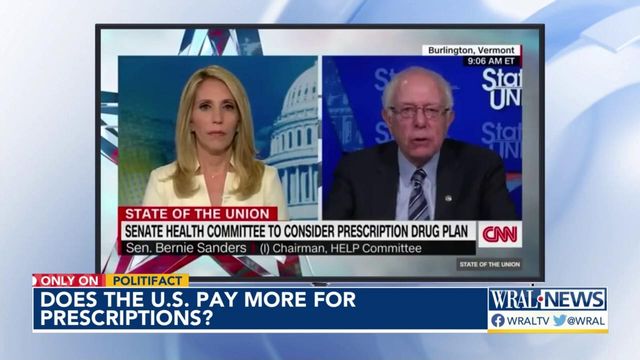Fact check: Sanders says prescription drug prices are '10 times' higher in the US
Sen. Bernie Sanders, I-Vt., whether in Congress or running for president, has often railed against the high cost of prescription drugs. Since becoming the chair of the influential Senate Health, Education, Labor and Pensions Committee this year, he’s made lowering drug costs a top priority.
It’s therefore unsurprising that the senator would, during a recent Sunday morning TV interview, rail against high drug prices in the United States and compare what Americans pay with what people in other countries must fork over.
"We pay by far the highest prices in the world for prescription drugs," Sanders said on CNN’s "State of the Union," adding, "in some cases 10 times more than the people of any other country."
Was he right about 10 times as much? We decided to check it out.
A complicated market
We first asked the senator’s office for documents to support Sanders’ claims. But our repeated requests went unacknowledged.
So, we dug around on our own and found, as expected, that Sanders was right in asserting that drug prices in the United States generally exceed those in other countries. The magnitude of the difference, however, varies depending on the drugs and the countries included in the comparison.
No matter how the studies we examined sliced the data, the drug price difference almost never reached Sanders’ stated level. But experts said his point has merit.
"I think the quote is on target, if a bit vague in scope," said Andrew Mulcahy, a senior health economist at the Rand Corp., a global policy think tank.
An oft-cited 2021 Rand study, based on 2018 figures, found drug prices in the U.S. were on average 2.56 times the drug prices in 32 other Organization for Economic Cooperation and Development countries. These are mostly high-income, developed nations. For brand-name drugs, the gap was even bigger: Americans paid 3.44 times the prices for those drugs, on average.
But the opposite was true for generic drugs, for which Americans paid just 84% of what people in other studied countries paid. One exception was Turkey. U.S. drug prices were nearly eight times higher than those in Turkey overall, and 10.5 times higher for brand-name drugs.
Mulcahy, a co-author of the report, said although the ratio across all drugs typically doesn’t reach Sanders’ 10-times-higher mark, "for some drugs it gets close if you look at the manufacturer’s list price."
The manufacturer price, though, is not necessarily the best measure for comparisons — especially if the idea is to capture what consumers are paying. That’s because it doesn’t reflect rebates and discounts negotiated by insurers and pharmacy benefit managers that can lower a drug’s retail price. Most people with health insurance are paying prices that include these discounts. Rand’s researchers used the manufacturer price, though, because the discounts are confidential and it’s hard to quantify how they affect net prices, the report noted.
Other studies have found smaller — though still significant — gaps than Sanders cited. In 2021, the Government Accountability Office released a comparative analysis of the prices of 20 brand-name drugs in the United States, Canada, Australia and France. The study, commissioned by Sanders himself, found that retail prices were more than two to four times what they were in the U.S.
Another analysis by the Peterson-KFF Health System Tracker compared the prices of seven brand-name drugs in the U.S., Germany, the Netherlands and the United Kingdom. It also found that some U.S. prices were about two to four times as high as those in other countries. But for other drugs, the gap was smaller.
The drugs tracked in this analysis "tend to be specialty drugs and expensive no matter where you buy them," said Cynthia Cox, director of the Peterson-KFF Health System Tracker, who co-authored the analysis.
Because the United States doesn’t directly regulate drug prices as many other countries do, some prices here are more expensive. In 2019, the United States spent $1,126 per person on prescription drugs, including $963 by health plans and $164 that people spent out of pocket, according to a KFF analysis of OECD data. Spending by comparable countries was $552 per capita, including $466 by health plans and $88 in out-of-pocket spending by individuals.
Experts added, though, that price is only one element that affects overall prescription drug spending.
"If we’re spending more, part of that might be because we’re paying higher prices, but it also might be because we’re using more medication," said Cox.
And then there is insulin
Where Sanders’ statement could be closer to spot-on , Mulcahy said, is in insulin prices. A Rand study done in 2020 for the Health and Human Services’ Office of the Assistant Secretary for Planning and Evaluation compared 2018 insulin prices in the United States with those in 32 other OECD countries. Their findings: The average U.S. manufacturer price for a standard unit of insulin sold domestically was more than 10 times the international price, $98.70 in the U.S. versus $8.81 in the OECD sample.
Such statistics have triggered a somewhat partisan rallying cry to address drug costs. Democrats supported a $35 per month cap for insulin costs in President Joe Biden’s Inflation Reduction Act, but Republicans voted to strip the provision. The price of insulin has been the subject of congressional hearings, including one earlier this month convened by Sanders.
A provision to cap insulin costs for Medicare recipients was preserved and became a signature win for Biden, some members of Congress, Sanders among them, want to slash insulin prices further. In a press release announcing a bill he introduced with Rep. Cori Bush, D-Mo., that would prohibit manufacturers from charging more than $20 per vial of insulin, Sanders said, "There is no reason why Americans should pay the highest prices in the world for insulin — in some cases, ten times as much as people in other countries."
PolitiFact ruling

When Sanders said Americans "pay by far the highest prices in the world for prescription drugs," he was on target. But his "10 times more" figure is off. Though that comparison may be accurate for some individual drugs or classes of drugs — and he did temper his comment by saying "in some cases" — it exaggerates overall differences in prices, which are generally higher here but not 10 times those in the rest of the world.
A now well-known exception is insulin: The price in the U.S. has been shown to be 10 times as high as in other countries.
But even this determination is complicated. Studies that showed a tenfold spread in prices for insulin drugs referred to manufacturer prices, which don’t factor in discounts. But that’s a misleading comparison because most people don’t actually pay manufacturer prices.
Sanders’ statement contains elements of truth but also doesn’t provide all the necessary information or context. We rate it Half True.













